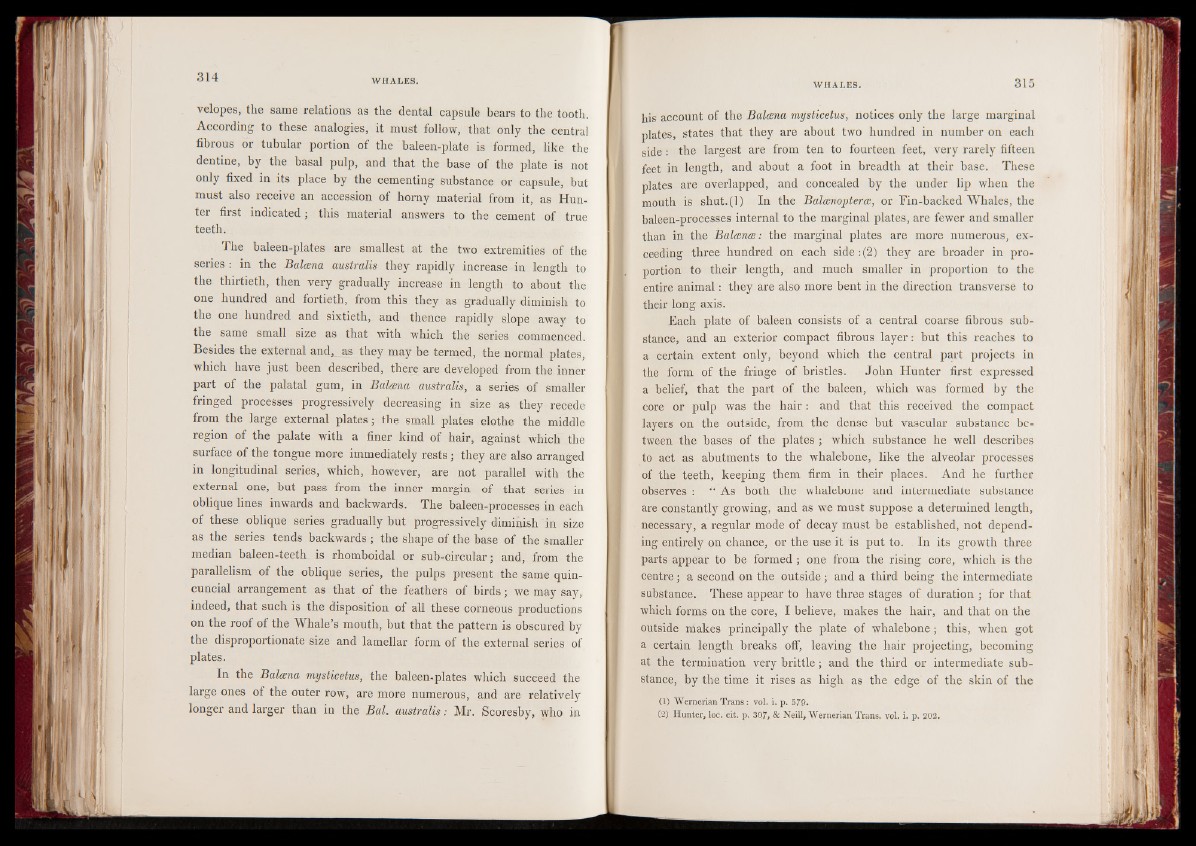
velopes, the same relations as the dental capsule bears to the tooth.
According to these analogies, it must follow, that only the central
fibrous or tubular portion of the baleen-plate is formed, like the
dentine, by the basal pulp, and that the base of the plate is not
only fixed in its place by the cementing substance or capsule, but
must also receive an accession of horny material from it, as Hunter
first indicated; this material answers to the cement of true
teeth.T
he baleen-plates are smallest at the two extremities of the
series : in the Balcena australis they rapidly increase in length to
the thirtieth, then very gradually increase in length to about the
one hundred and fortieth, from this they as gradually diminish to
the one hundred and sixtieth, and thence rapidly slope away to
the same small size as that with which the series commenced.
Besides the external and, as they may be termed, the normal plates,
which have just been described, there are developed from the inner
part of the palatal gum, in Balcena australis, a series of smaller
fringed processes progressively decreasing in size as they recede
from the large external plates; the small plates clothe the middle
region of the palate with a finer kind of hair, against which the
surface of the tongue more immediately rests; they are also arranged
in longitudinal series, which, however, are not parallel with the
external one, but pass from the inner margin of that series in
oblique lines inwards and backwards. The baleen-processes in each
of these oblique series gradually but progressively diminish in size
as the series tends backwards ; the shape of the base of the smaller
median baleen-teeth is rhomboidal or sub-circular; and, from the
parallelism of the oblique series, the pulps present the same quin-
cuncial arrangement as that of the feathers of birds; we may say,
indeed, that such is the disposition of all these corneous productions
on the roof of the Whale’s mouth, but that the pattern is obscured by
the disproportionate size and lamellar form of the external series of
plates.
In the Balcena mysticetus, the baleen-plates which succeed the
large ones of the outer row, are more numerous, and are relatively
longer and larger than in the Bal. australis: Mr. Scoresby, who in
his account of the Balcena mysticetus, notices only the large marginal
plates, states that they are about two hundred in number on each
side: the largest are from ten to fourteen feet, very rarely fifteen
feet in length, and about a foot in breadth at their base. These
plates are overlapped, and concealed by the under lip when the
mouth is shut.(l) In the Balcenopterce, or Fin-backed Whales, the
baleen-processes internal to the marginal plates, are fewer and smaller
than in the Balcence: the marginal plates are more numerous, exceeding
three hundred on each side:(2) they are broader in proportion
to their length, and much smaller in proportion to the
entire animal: they are also more bent in the direction transverse to
their long axis.
Each plate of baleen consists of a central coarse fibrous substance,
and an exterior compact fibrous layer: but this reaches to
a certain extent only, beyond which the central part projects in
the form of the fringe of bristles. John Hunter first expressed
a belief, that the part of the baleen, which was formed by the
core or pulp was the hair: and that this received the compact
layers on the outside, from the dense but vascular substance between
the bases of the plates ; which substance he well describes
to act as abutments to the whalebone, like the alveolar processes
of the teeth, keeping them firm in their places. And he further
observes : “ As both the whalebone and intermediate substance
are constantly growing, and as we must suppose a determined length,
necessary, a regular mode of decay must be established, not depending
entirely on chance, or the use it is put to. In its growth three
parts appear to be formed ; one from the rising core, which is the
centre; a second on the outside ; and a third being the intermediate
substance. These appear to have three stages of duration ; for that
which forms on the core, I believe, makes the hair, and that on the
outside makes principally the plate of whalebone; this, when got
a certain length breaks off, leaving the hair projecting, becoming
at the termination very brittle; and the third or intermediate substance,
by the time it rises as high as the edge of the skin of the
(1) Wernerian Trans : vol. i. p. 579.
(2) Hunter, loc. cit. p. 3Q7, & Neill, Wernerian Trans, vol. i. p. 202.